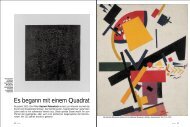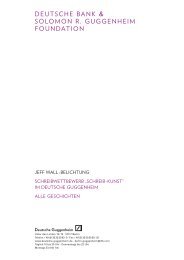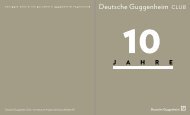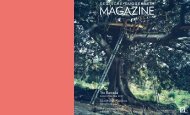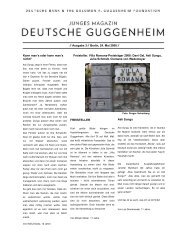DG Magazin - Deutsche Guggenheim
DG Magazin - Deutsche Guggenheim
DG Magazin - Deutsche Guggenheim
Sie wollen auch ein ePaper? Erhöhen Sie die Reichweite Ihrer Titel.
YUMPU macht aus Druck-PDFs automatisch weboptimierte ePaper, die Google liebt.
Context<br />
Installation view: Vues d’en<br />
haut, vertiges et constellations,<br />
Jeu de Paume, Paris, April 7–<br />
June 7, 2009<br />
kriminellen Handlung wie dem Häuserbesetzen oder dem Herumlungern<br />
auf öffentlichen Plätzen – nur dass es flüchtig ist und<br />
keine Spuren hinterlässt. Wie auch ihr Mann, von dem sie sich<br />
schließlich trennte, stellte sich Snow als Dissidentin oder künstlerische<br />
Demonstrantin gegen den Mainstream dar. Für eine Weile<br />
protestierte sie sogar gegen die Kommerzialisierung ihrer Kunst.<br />
Doch anders als bei ihrem Mann war Snows Außenseiterstatus<br />
aktenkundig. Diese frühen Arbeiten, in denen es um das Herstellen<br />
von Gemeinschaft geht, kann man biografisch als den Versuch<br />
deuten, sich temporäre Formen eines Zuhauses zu schaffen.<br />
Gebäude waren keine Symbole für Sicherheit und Zivilisation<br />
© Agathe Snow. Photo: Arno Gisinger, Jeu de Paume<br />
this dance marathon perfectly echoed the city’s psychology after<br />
9/11, where forcing oneself toward maximum elation in spite of<br />
tragedy and in an attempt to survive might make this one of the<br />
most insightful and underrecognized works of the last decade.<br />
During this period, she also planned a series of concept dinners<br />
that were initially held in stairways, on stoops, and in apartments,<br />
extending this critical attribute of a work that acts like an inva-<br />
sion—a criminal activity comparable to squatting or loitering—<br />
but is fleeting in that it leaves no trace behind. Like her husband<br />
(from whom she eventually separated), Snow was aligning herself<br />
against the mainstream as a dissident or artistic protestor<br />
(for a while even protesting the commodification of her art). Un-<br />
like her husband, Snow’s outsider status was a fact of government<br />
record. These early pieces of frank community galvanization<br />
could be read biographically as an attempt to create temporary<br />
homes. Buildings were no longer the arrant symbols of safety or<br />
civilization. For this foreign national, those humane conditions<br />
themselves were conditional, and their potential existed only in<br />
drawing people together and making them the essential ingredients<br />
of the work.<br />
Place is a key factor in Snow’s oeuvre. For an immigrant, the act<br />
of claiming a place becomes an overt social mechanism for naturalization.<br />
But in America during the last decade, where even the<br />
most powerful economic symbols and desires collapsed, and spe-<br />
cifically for an already marginalized, urban female artist, place<br />
becomes a shifting, temporal, entirely unnatural (naturalization<br />
being, in itself, not natural) prospect for adaptation. In her dance<br />
marathons and spree dinners, Snow produced a democratic art<br />
that honors humanity without monumentalizing it. Unsurprising-<br />
ly, when she turned to sculpture, she used found materials for a<br />
series of tectonic detritus studies that either looked like erratic<br />
debris piles (in the case of a 2007 solo show called No Need to<br />
Worry, the Apocalypse Has Already Happened … when it couldn’t<br />
get any worse, it just got a little better) or anthropomorphic shapes<br />
that hung like mobiles (in a 2008 show entitled Just Say Yes). Snow<br />
was continually attracted to items that had wheels such as carts<br />
and wheelbarrows, so these forms purposely did not possess fixity.<br />
She used objects that cannot be recycled—hard plastics, tires—<br />
and that not only refuse to grow roots due to their inability to disintegrate<br />
but also instantly announce themselves as unwanted<br />
rubbish. Out of these eruptive physical unions, Snow created<br />
poetic instances, flotsam structures that look vertiginously in danger<br />
of toppling over. Much like her own identity, they operate as<br />
small, mortal monuments to their willful subsistence.<br />
Snow proposes a humanistic art that is moving, exchangeable,<br />
and modulated by the participant in time, perhaps explaining her<br />
continual focus on physically moving the audience. In two solo<br />
shows in 2008 and 2009, she created compositional “wreaths,”<br />
eight-foot circular frames, first strung with landfill items like vac-<br />
uum cleaners, the next with shiny, ornamental decorations. In both<br />
cases the viewer could pass through them as if jumping through<br />
hoops. Here she relegated the objects to the periphery, allowing<br />
the viewer to stand in the center, inviting him or her to activate a<br />
sculptural performance—in some way, taking the role of subject<br />
in a frame. In another recent show A.S. Still A.S. Life (2010), she<br />
fabricated a secret garden of hanging sculptures that drifted over<br />
the ground from orange chains, each of the fourteen bodies created<br />
from painted fabric, beads, and wood blocks fashioning a<br />
portrait of a different man she had loved. At the end of the opening,<br />
she improvised a slow dance, where visitors could actually<br />
mehr. Als ausländische Staatsangehörige waren für Snow vielmehr<br />
die menschlichen Beziehungen bindend. Ihr Potential konnte sie<br />
nur entwickeln, wenn sie Menschen zusammenbrachte und zum<br />
unerlässlichen Bestandteil ihrer Arbeit erklärte.<br />
Der Ort ist ein entscheidender Faktor in Snows Oeuvre. Für<br />
einen Einwanderer gehört der Akt, einen Ort für sich zu beanspru-<br />
chen, zum gesellschaftlichen Mechanismus der Einbürgerung,<br />
zur „naturalization“, wie es im Amerikanischen heißt. Aber im<br />
Amerika des letzten Jahrzehnts, in dem die mächtigsten ökonomischen<br />
Symbole und Sehnsüchte kollabierten, wird der Ort für<br />
eine ohnehin schon marginalisierte, urbane Künstlerin zu etwas<br />
schwer Greifbarem, Temporärem, ganz und gar Unnatürlichem,<br />
das man kaum adaptieren kann. Mit ihren Tanzmarathons und<br />
tourenden Dinnern entwickelte Snow eine demokratische Kunstform,<br />
die das Menschliche ehrt, ohne es ins Monumentale zu<br />
erheben. Dementsprechend nutzte sie, als sie sich der Skulptur<br />
zuwendete, vorgefundenes Material – etwa bei der Serie von tektonischen<br />
Geröllstudien, die sie 2007 in ihrer Schau No Need to<br />
Worry, the Apocalypse Has Already Happened … when it couldn’t<br />
get any worse, it just got a little better zeigte, oder bei den anthropomorphen<br />
Formen, die sie 2008 in Just Say Yes von der Decke<br />
baumeln ließ. Snow war immer von Dingen mit Rädern, Einkaufswagen<br />
oder Schubkarren, fasziniert, weil sie keine Beständigkeit<br />
und Festigkeit vermitteln. Sie nutzt Materialien, die man nicht<br />
recyceln kann – wie Hartplastik oder Reifen –, die im wahrsten<br />
Sinne keine Wurzeln schlagen, weil sie nicht verrotten und sofort<br />
als ungewollter Müll erkennbar sind. Aus diesen eruptiven physischen<br />
Vereinigungen kreiert Snow Poetisches, schwindelerregende<br />
Strukturen aus Treibgut, die aussehen, als drohten sie umzustürzen.<br />
Ähnlich wie Snows eigene Identität operieren sie als kleine,<br />
sterbliche Monumente für ihre eigenwillige Existenz.<br />
Snow schlägt eine humanistische Kunst vor, die beweglich<br />
und austauschbar ist und von den Mitwirkenden jedes Mal neu<br />
geformt wird. Dies erklärt vielleicht, warum sie sich so darauf fokussiert,<br />
das Publikum auch körperlich zu bewegen. Für zwei Einzelschauen,<br />
2008 und 2009, hat sie “Kränze” geschaffen – runde<br />
Gestelle mit beinahe 2,50 m Durchmesser, von denen der erste<br />
aus entsorgtem Müll wie Staubsaugern bestand, der zweite hingegen<br />
aus glänzendem, ornamentalem Dekoschmuck zusammen-<br />
gesetzt war. In beiden Fällen konnte der Betrachter sich durch sie<br />
bewegen, als würde er durch einen Reifen hüpfen. Snow wies ihren<br />
Objekten eine periphere Bedeutung zu und erlaubte dem<br />
Betrachter, sich in den Mittelpunkt der Arbeit zu stellen. Sie lud<br />
ihn dazu ein, eine skulpturale Performance in Gang zu setzen –<br />
wobei er auf gewisse Weise die Rolle eines eingerahmten Subjektes<br />
spielte. In der kürzlich gezeigten Ausstellung A.S. Still A.S.<br />
Life (2010) hat sie einen geheimen Garten angelegt: Skulpturen<br />
baumelten an orangen Ketten über dem Boden, wobei jeder<br />
der 14 Körper aus bemaltem Stoff, Perlenschnüren und Holz-<br />
blöcken das Porträt eines Mannes darstellte, den Snow einmal<br />
geliebt hatte. Gegen Ende der Eröffnung improvisierte sie einen<br />
langsamen Tanz, bei dem die Besucher um die schwebenden Figuren<br />
herum, zwischen ihnen hindurch und mit ihnen tanzen<br />
durften. Diese sehr persönliche Hagiographie diente ihr auch für<br />
ihre temporären Tanz-Partys, in die sie Souvenirs unterschiedlicher<br />
Epochen und Länder einbezog: eine Kunst ohne Grenzen,<br />
ohne Sockel, entledigt von der Aura des Unberührbaren. Diese<br />
Monumente waren auf ihre etymologischen Wurzeln herunter<br />
gekocht – Denkmal, Gedenken, Gedächtnis. Vielleicht wurde dieser<br />
Versuch, den Nicht-Ort der Schöpfung zu lokalisieren, am<br />
glide around, into, and even with these floating figures. This very<br />
personal hagiography also worked as a temporary dance party<br />
consisting of souvenirs from shuffling periods and countries: art<br />
without borders, without pedestals, without even their aura of<br />
untouchability. They were monuments boiled down to the etymological<br />
root—memorial, memory, to remind. Perhaps, this<br />
attempt at locating the nonplace of creation is best represented<br />
in the 2008 show at Peres Projects called Moving. Suddenly no<br />
longer able to keep her apartment in New York’s Chinatown, Snow<br />
packed all of her possessions in a van and drove across the country<br />
to the gallery in Los Angeles’s Chinatown. In between she only<br />
ate at Chinese restaurants. The resulting work was the unloaded<br />
contents of her life. No longer a resident of anywhere, Snow was<br />
a self-proclaimed peripatetic citizen of Chinatown. Chinatown<br />
existed wherever its resident went, purposely obfuscating the<br />
role of place from the declaration of citizenship.<br />
Agathe Snow, The Goldfinch,<br />
2008. Curtain rods, key<br />
chain, papier-mâché, acrylic,<br />
thrift-store jacket, plastic,<br />
thread, and ceramic,<br />
39 × 25 × 92 cm. Solomon R.<br />
<strong>Guggenheim</strong> Museum, New<br />
York, Purchased with funds<br />
contributed by the Young<br />
Collectors Council 2008.58<br />
10 <strong>Deutsche</strong> <strong>Guggenheim</strong> <strong>Magazin</strong>e<br />
Issue 14 Winter 2011<br />
11<br />
© Agathe Snow. Photo: Farzad Owrang, courtesy James Fuentes LLC, New York



